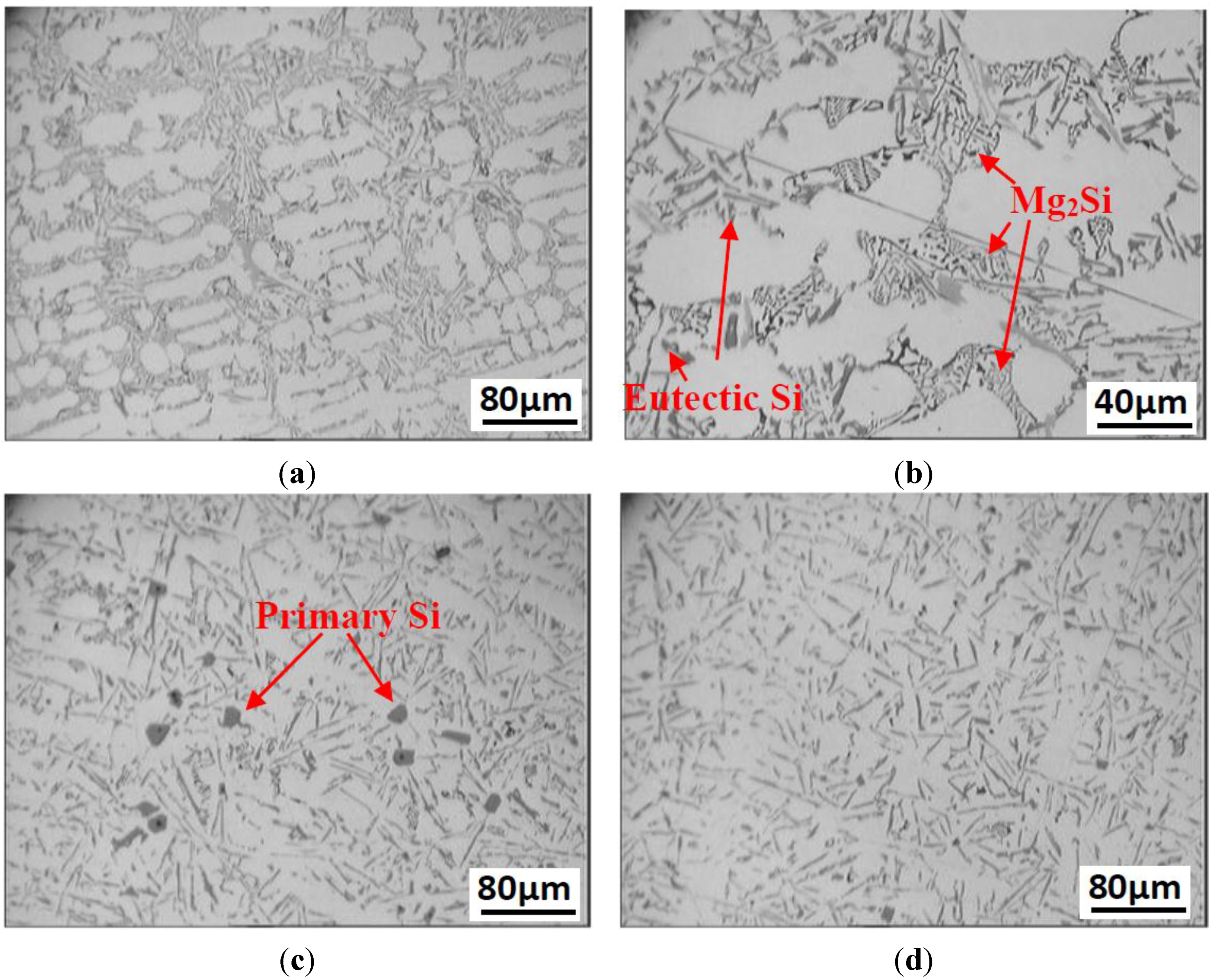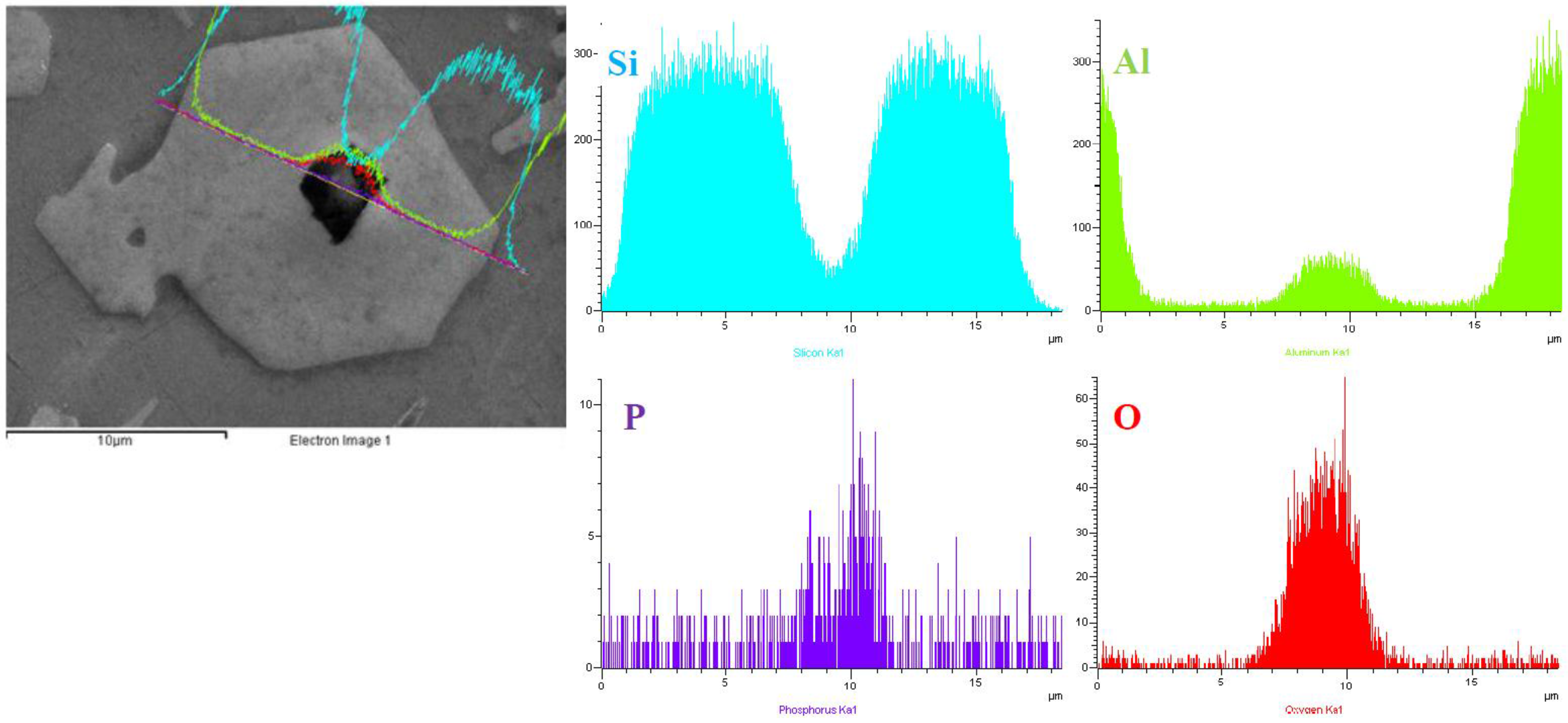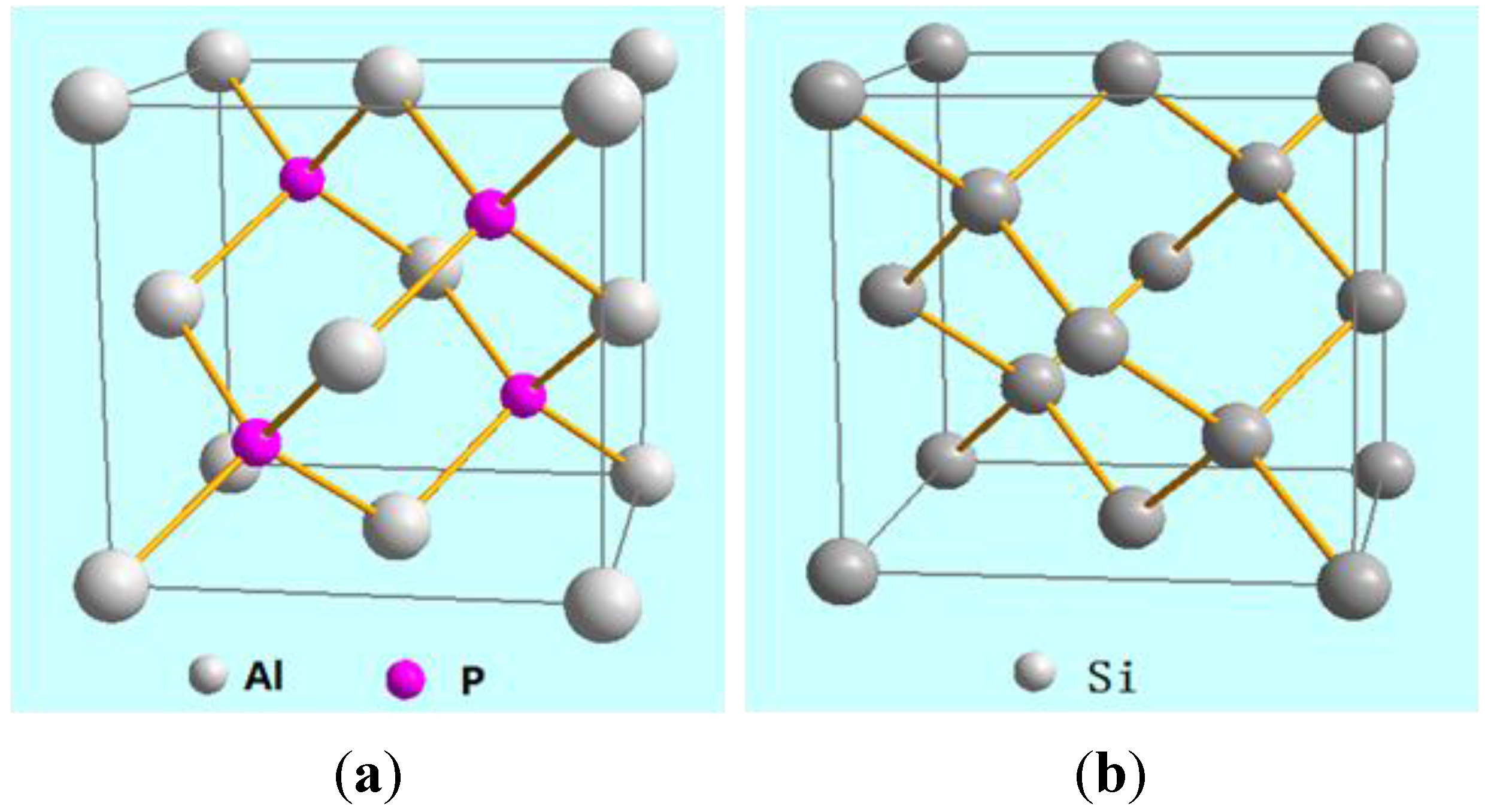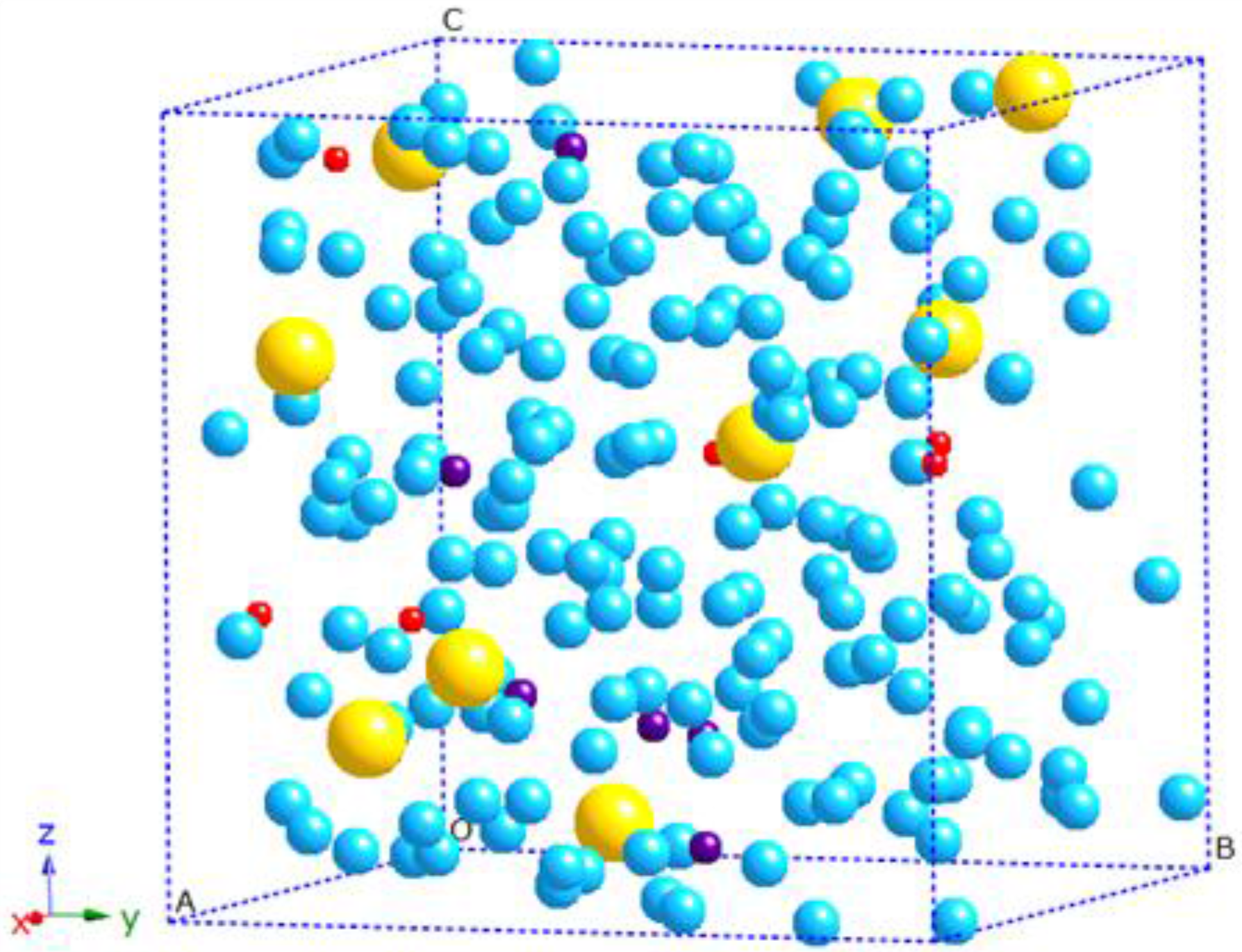3. Results and Discussion
Figure 2 shows the microstructures of three Al-12.6Si-1.5Mg alloys. It is clear that the Si phase in the A alloy without P exists in the form of eutectic Si phase, and the Mg
2Si phase also exists in the matrix, as shown in
Figure 2a,b. There is no proper Al-Si-Mg diagram that can describe in detail all the phases (containing α-Al, eutectic Mg
2Si, primary Si and eutectic Si) in Al-12.6Si-1.5Mg alloys, but we can speculate on these phases based on the binary Al-Si and Mg-Si diagrams. As it is well known, Al-12.6% Si is just the eutectic Al-Si alloy. However, since part of Si atoms was bonded by Mg atoms to form Mg
2Si phase, the content of Si which would crystallize as Si phase is less than 12.6%. Therefore, the microstructure of Al-12.6Si-1.5Mg alloy possesses the characteristics of hypoeutectic Al-Si alloys, and no primary Si particles were found. While, when Al-P alloy was added into the melt after adding Mg, some small primary Si particles appear, as shown in
Figure 2c.
Figure 2.
The microstructures of Al-12.6Si-1.5Mg alloys: (a,b) A alloy; (c) B alloy with some primary Si grains, into which Al-P alloy was added after adding Mg; (d) C alloy with few primary Si grains, into which Al-P alloy was added before adding Mg.
Figure 3.
The EDS analysis of the black phase in the center of a primary Si particle. The black phase contains Al, P and O, and is considered as AlP.
Figure 3 shows the EDS analysis of a typical primary Si particle. It was found that a black phase exists in the center of primary Si phase, and is rich in Al, P and O elements. It is considered that this black phase is AlP, and the existence of O element is due to the oxidation and hydrolysis of AlP during specimen preparation [
7]. AlP phase and Si phase have the same face-centered cubic (fcc) crystal structure and very similar lattice parameters (a
AlP = 5.45 Å, a
Si = 5.42 Å), as shown in
Figure 4. So, AlP can act as the highly effective heterogeneous nucleation substrate for primary Si phase. Due to the existence of AlP, many Si atoms in this eutectic melt could be absorbed and bonded by AlP during solidification, and then precipitated as primary Si phase, rather than eutectic Si phase. This transformation from the eutectic Si phase to the primary Si phase is the aim of the phosphorous-modification.
Figure 4.
The crystal structures of (a) AlP; (b) Si. They both have face-centered cubic structure, and aAlP = 5.45 Å, aSi = 5.42 Å.
Figure 2d displays the microstructure of C alloy. Though the C alloy was also supplied with Al-3P alloy, it has few primary Si particles. It indicates the AlP did not play its role of heterogeneous nucleation substrate. Compared with B alloy, the only difference in the preparation process is the order of adding Mg element. It is supposed that Mg plays a pivotal role in reducing the modification effect of AlP.
It is well known that the liquid metal is the source of casting, and the solid microstructure originates from the liquid structure. The liquid structure of the Al-Si-Mg-P alloy was analyzed using AIMD simulations to investigate the solidification mechanisms caused by particular Mg alloying orders. As discussed above, it is considered that the reactions related with Mg are the key point. It seems that Mg may react with AlP, according to our experimental results. In general, Mg tends to strongly react with the Si element to form Mg2Si. Hence, the competition between the above two reactions should be investigated, and the affinities of P-Mg and Si-Mg were analysed in this study. For the convenience of comparing these two affinities, the atomic percents of Si and P were all set to the same value (3%). The atomic percent of Mg was set as 4.5%. So, the ration of Mg to P is just that in Mg3P2 compound, and the ration of Mg to Si is less than that in Mg2Si compound. In other words, the content of Si is in excess, which could enhance the affinity of Si-Mg and is a little similar with the conditions in the experimental melt.
Figure 5 shows the partial correlation functions (PCFs) of Al
179Mg
9Si
6P
6 alloy at 1173 K. In order to describe the liquid structure of this Al-Si-Mg-P alloy comprehensively, there needs to be 10 PCFs, namely, g
PAl(r), g
PMg(r), g
PSi(r), g
PP(r), g
MgAl(r), g
MgMg(r), g
MgSi(r), g
SiAl(r), g
SiSi(r) and g
AlAl(r). Since the g
AlAl(r) is rather normal, we only present the other nine PCFs in this investigation. To facilitate the comparison and analysis, three figures, which are related with P, Mg and Si, respectively, are used to show these nine PCFs.
Four P-related g(r) curves are plotted in
Figure 5a. It is observed clearly that the first peak of the g
PMg(r) curve is much higher than those of other three
P-related g(r) curves, indicating that the affinity of P-Mg pairs is strongest. The P-Al pairs have a second strong affinity. Now, we tend to g
PSi(r) and g
PP(r) curves. Since the second peak of g
PSi(r) curve is more obvious than the first peak, the Si atoms tend to exist at the second coordination shell rather than at the first coordination shell of P atoms, avoiding meet P atoms directly. The atomic radius of P atom is 0.11 nm. So, if there were P-P pairs, a pronounced first peak should be at 0.22 nm. However, the g
PP(r) curve in
Figure 1a does not demonstrate the first peak at 0.22 nm, meaning the P-P pairs are extremely scarce. The structural information from g
PSi(r) and g
PP(r) curves is in good accordance with our previous study [
17]. On the basis of above analysis, it can be concluded that P atoms tend to combine with Mg atoms preferentially and then with Al atoms, but would not bond with Si atoms or other P atoms. It also can be shown that Mg element has the potential to eliminate P-Al clusters and reduce the modification effect of AlP.
Figure 5.
The partial pair correlation functions of Al179Mg9Si6P6 system at 1173K. (a) g(r) curves related with P element; (b) g(r) curves related with Mg element; (c) g(r) curves related with Si element. The g(r) curves show that the affinity of P-Mg is strongest, followed by Mg-Si and P-Al.
The chemical environment around P atoms is shown in
Table 1. In the table,
Nij is the partial coordination number around a P atom,
Rij is the percentage of element
i in the partial coordination number of element
j. The parameter
Dij is the deviation degree between
Rij and its nominal value (random distribution), reflecting the chemical short-range order (CSRO) around P atoms.
Dij is defined as:
Table 1.
Chemical environment around P atoms.
| Terms | Nij | Rij (%) | Nominal | Dij (%) |
|---|
| 1173 K | 1373 K | 1173 K | 1373 K | 1173 K | 1373 K |
|---|
| PAl | 5.91 | 5.95 | 88.70 | 92.15 | 89.50 | −0.89 | 2.96 |
| PMg | 0.72 | 0.46 | 10.75 | 7.16 | 4.50 | 138.89 | 59.11 |
| PSi | 0.04 | 0.05 | 0.54 | 0.69 | 3.00 | −82.00 | −77.00 |
| PP | 0.00 | 0.00 | 0.00 | 0.00 | 3.00 | −100 | −100 |
Both at 1373 K and 1173 K, the partial coordination numbers of Al atoms around P atoms (5.95 and 5.91, respectively) are very close to 6, which is similar with that in the Al-Si-P system [
17]. While, the number of Mg atoms in the first coordination shell is less than 1. It should be noted the number of Al atoms is high, mainly because the solvent Al atoms are extremely plentiful in this Al-rich melt, and not because the P-Al cluster is the strongest cluster. To measure the strength or importance of the clusters,
Rij and
Dij should be investigated.
At 1373 K, the RPAl (92.15) and RPMg (7.16) are all greater than their nominal values (89.50 and 4.50). However, the DPAl is only 2.96, meaning that the Al content in the first coordination shell of P atoms is just a little higher than the nominal value (random distribution). In other words, P-Al cluster is not a very strong cluster in this system. For P-Mg pairs, the value of DPMg is up to 59.11. It means P atoms have a higher tendency to combine with Mg atoms.
Moreover, when the temperature is cooled down to 1173 K, the partial coordination number of Mg atoms increases and the value of DPMg reaches 138.89. While, the three parameters of P-Al pairs (NPAl, RPAl and DPAl) all reduce as the temperature drops. These changes of parameters indicate that the P-Mg cluster would be enhanced and P-Al cluster would be weakened during the solidification process. What should be paid particular attention is that the DPAl is −0.89. This negative value is of much significance: when the temperature is below 1173 K, the CRSO between P atoms and Al atoms is very weak, and the P-Mg cluster is the most pronounced cluster in this alloy.
The structural information of P-Si pairs and P-P pairs is also shown in
Table 1. The parameters
NPSi, which are only 0.05 at 1373 K and 0.04 at 1173 K, demonstrate that the partial coordination number of Si atoms is very little, and becomes lower as the temperature decreases. As for P-P pairs, the
NPP value of 0 and
DPP value of −100 declare that in fact there are no P-P pairs in the melt.
Now, based on the above integrated information from the g(r) curves and chemical environment, the behavior rule of P atoms is revealed. When P atoms enter the melt, they react with Mg atoms preferentially, followed by Al atoms. Furthermore, P atoms do not combine with Si atoms and other P atoms.
According to the behavior rule of P atoms, it seems that the addition of Mg would eliminate part of P-Al cluster and reduce the modification effect of AlP, according to the conditions of C alloy. However, when the Mg was added to Al-Si melt before adding Al-P alloy, the modification effect was positive, just as in the case of B alloy. So, the behavior rule of Mg atoms should also be studied carefully.
Figure 5b shows the four Mg-related g(r) curves. It is obvious the first peak of g
MgP(r) curve is much higher than those of other three g(r), implying that Mg atoms tend to combine with P atoms, preferentially. It should be known that g
ij(r) is equal to g
ji(r) in simulation, so g
MgP(r) is the same with g
PMg(r). The next most important curve is the g
MgSi(r) curve, which has the second-ranked peak. Hence, for Mg atoms, it is the second-favorite choice to combine with Si atoms. Then, Al atoms also have a certain degree of potential to bond with Mg atoms, but Mg-Mg pairs are few. The Si-related g(r) curves are also considered, as shown in
Figure 5c. With regards to Si atoms, combining with Mg atoms is the preferred choice. It means that the Mg atoms would form Mg-Si clusters in Al-Si melt.
One arbitrary configuration out of 2000 is visualized in
Figure 6. By inspection of the visualized configurations, it is found that P atoms tend to be near Mg atoms, and so do Si atoms, agreeing with the information from g(r) curves.
Figure 6.
Visualization of an arbitrary configuration of liquid Al179Mg9Si6P6 system at 1173 K (Al: blue ball; Mg: yellow ball; Si: violet ball; and P: red ball).
Based on the above analysis, the three strongest clusters are listed as follows: (1) P-Mg cluster > (2) Mg-Si cluster > (3) P-Al cluster.
Among them, the P-Mg cluster is much stronger than the other two clusters. However, the fact that the first peak of gMgSi(r) curve is just a little higher than that of gPAl(r) shows that the Mg-Si cluster is just a little stronger than P-Al cluster in this Al179Mg9Si6P6 system.
It should be specially mentioned that the above analysis reflects the conditions of the melt in equilibrium. While, in our experiments, the raw materials are not added to the Al-Si melt at the same time. So, some pre-existing clusters would come into being when the first addition has been completed but the second addition has not been done. Even after the second addition, those pre-existing can also survive for a certain time. They need some time to evolve to equilibrated clusters. However, if the melt was casted before it could reach the balanced or near-balanced state, the survived pre-existing clusters would play a role, making the solid microstructure different from the equilibrated microstructure.
Figure 7.
The schematics of the two evolution paths of the Al-Si-Mg-P liquid melt structure induced by changing order of adding Mg and its resulting solidification microstructure. (a) when pure Mg was added into Al-Si melt before addition of Al-P alloy, Mg-Si clusters formed firstly and can coexist with P-Al clusters. In the solidification process, the P-Al clusters can precipitate as AlP and then lead to the forming of primary Si; (b) when pure was added in to melt after the addition of Al-P alloy, P-Al clusters were invaded by active Mg atoms dissolved from pure Mg and then evolved into P-Mg clusters. In the solidification process, P precipitated as Mg3P2, rather than AlP. So, no primary Si particles formed due to the absence of AlP.
Figure 7 depicts the two evolution paths of the Al-Si-Mg-P liquid melt structure induced by implementing different adding orders of Mg. For B alloy, its evolution path is relatively simple and can be divided into three stages, as shown in
Figure 7a. In stage I, pure Mg was added into the binary Al-Si melt. In this phosphorous-free melt, the high-active Mg atoms would bond Si atoms and form Mg-Si clusters. The Al-P alloy was added into the melt in the following stage II. Then, AlP compound, which preexists in the Al-P alloy, would dissolve in the melt and evolves into P-Al clusters. That is to say the Mg-Si clusters co-existed with P-Al clusters at the beginning of the stage II. According to the above AIMD results of the melt in equilibrium, the Mg-Si clusters should react with P-Al clusters and evolve to P-Mg clusters. While, considering the experimental result of alloy B, it is speculated that this evolution in the experimental melt could not be finished in a short time: (1) In the experimental Al-12.6Si-1.5Mg-0.03P melt, the amounts of Al atoms and Si atoms are much more than these of Mg atoms and P atoms. So, The P-Al clusters are the P-centered clusters [
17], and Mg-Si clusters are the Mg-centered clusters. If P atoms could combine with Mg atoms to form P-Mg clusters, P atoms should get close to and go through the Si atoms zone surrounding the centered Mg atoms in Mg-Si clusters. While, as discussed above, there exists a large tendency to repel each other between P atoms and Si atoms, which blocks the formation of P-Mg clusters. (2) The electronegativity, which was introduced by Pauling in 1932 [
18], is a chemical property that describes the tendency of an atom or a functional group to attract electrons (or electron density) towards itself. The electronegativity difference actually reflects the bonding nature of atomic pairs in alloys. The lager electronegativity difference between constituent elements helps the formation of clusters and compounds [
19]. While, according to the electronegativity equalization principle, once Mg atoms combine with Si atoms to form Mg-Si clusters, the electronegativity of Mg would increase, decreasing the electronegativity difference between Mg and P atoms. So, the tendency of Mg to combine P becomes weak. In other words, the Mg atoms in Mg-Si clusters have a lower activity, losing the ability to eliminate P-Al clusters quickly. Therefore, P-Al clusters could coexist with Mg-Si clusters for a long time. However, after only 40 min, the melt was poured into a mould and solidification (stage III) took place. With the decrease in the melt temperature, the co-existing Mg-Si clusters and P-Al clusters grew into crystalline phases correspondingly: Mg
2Si and AlP phases. As the highly effective heterogeneous substrate for primary Si phase, AlP could absorb and bond many Si atoms, and then make them precipitate as primary Si phase, resulting in a microstructure like that of B alloy.
As discussed above, Si plays a suppressive role in the elimination of part of P-Al clusters induced by Mg and ensures a good phosphorous-modification effect (
i.e., ensure the transformation from part of eutectic Si plates to some small and distributed primary Si grains), by combining with Mg atoms and reducing the activity of Mg. This phenomenon also appeared in Li’s experiment [
20]. In his experiment, the prepared Al-20Mg
2Si-3Si alloy could also be modified by AlP. The content of Mg in the prepared Al-20Mg
2Si-3Si alloy is up to 12.7%, but all Mg atoms were bonded with Si atoms and existed in the Mg-Si clusters before adding Al-P alloy. So, Mg had no effect on the phosphorous-modification
As for the C alloy, its evolution path can be divided into four stages, as shown in
Figure 7b. The Al-P alloy was added firstly in stage I, resulting in many P-Al clusters appearing in the Al-Si melt. In the next stage II, pure Mg with high activity was added and dissolved into the melt. As discussed above, elemental Mg tends to combine with P atoms preferentially. So, the pre-existing P-Al clusters were invaded by these active Mg atoms and then evolved into P-Mg clusters in a short period of time (stage III). Of course, Mg atoms are excessive, and most of them also combined with Si atoms, forming Mg-Si clusters. The next stage IV is the solidification. P would precipitate in the form of Mg
3P
2, which could not induce the formation of primary Si. So, the microstructure of C alloy has few primary Si grains.












